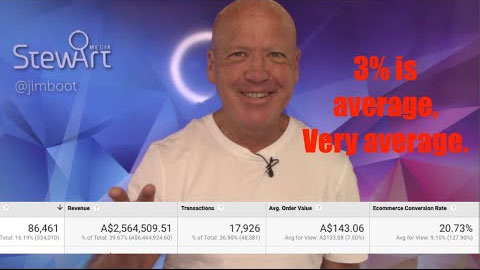
by Jim October 4, 2022
Welcome back! I’ve been pondering what constitutes a solid conversion rate and how, as an industry, we agreed on 3%. Personally, I’ve always thought that was a bit low. There are obvious differences between online and bricks and mortar, but you should be digging down to see how you can lift that number.
What I learned
- Why did we settle on 3%?
- That figure doesn’t sound right in bricks & mortar.
- Why 97% aren’t buying anything.
- Desktop should be the best device.
- Why Google Ads convert better.
Transcript
… didn’t buy from you. And the reason for this… There’s actually a spider on my lens. Sorry about that. You can see it crawling across the lens. Hey, welcome back, Rankers. How you going? Had to record again because a spider just crawled across my lens. A very Australian problem. A question we often get asked is, what’s a good conversion rate? And you may have asked that of someone yourself. And typically, the response is always, “I don’t know, about 3%.” And 3% has been the industry standard for God knows how long. I don’t know why. And it always struck me as being odd because three out of 100 people buying from you just doesn’t seem right. If that happened in a bricks and mortar store, you’d probably be sacking a few staff, I’d say.
The online difference
But people will say, “Well, online’s a bit different because you’ve got people bouncing around from site to site to site to site, and there’s a lot of stuff happening and it’s easy to get distracted. There’s no salesperson standing next to you.” But rather than worry about the 97% that didn’t buy from you, what we should be doing and the question we should be asking is, who are these 3% that did buy from us? Because once you work out who the best converting customers or the best converting shoppers are and where they come from, what devices they’re on, and how they navigate the store, then that is going to tell you a lot more about the 97 people that didn’t buy from you. And a typical example of that is most businesses, their best converting channel is going to be people coming in via an email on desktop using site search.
And the reason for that is, A, site search makes it easy to find stuff. B, they already trust you. They’ve signed up to your newsletter. They know who you are. Maybe they already know the idiosyncrasies about your site as well. And, C, they’re on desktop. Why? Desktop’s much easier to use than mobile. It doesn’t have reception problems. It doesn’t have things moving about. It doesn’t have screens, hard to see. It’s not sly. All of those things. So, desktop’s going to convert better. Now, when you look at that and when you go and drill down into your different channels and the devices and how they’re navigating the site, that can tell you a lot. Simple things like, maybe your Google Ads convert a lot better than your Google Organic, but they’re both coming from search. Why is that Jim?
Why Google Ads convert better
Well, the reason for that is usually Google Ads is much better at targeting buyers whereas our industry, the SEO industry, has been more focused on targeting traffic. So typically, a lot of the traffic that comes out of SEO will convert lower because it’s attracting the readers, not buyers, as we’ve talked about before. So rather than think about, what is a good conversion rate? Understand what your shoppers are doing now and who’s converting best. Do you even know that maybe one brand of phone isn’t converting as well as, say, another brand of phone? Things like that. And if you’ve got a lot of volume and a lot of traffic, that can make a huge difference. Remember, if you’ve got low conversion rates, you’re either bringing in the wrong traffic or there’s something terribly wrong with your site and your business.
Usually, it’s not to do with your business. Usually, you’ve done your price checks. Usually, you know you’re competitive. Typically, there’s something that’s wrong with your site and you’re bringing in the wrong people. Hopefully, that’s helpful. Please like, share, subscribe, and tell your friends. And we’ll see you next week. Thanks very much. Bye.

Jim’s been here for a while, you know who he is.



